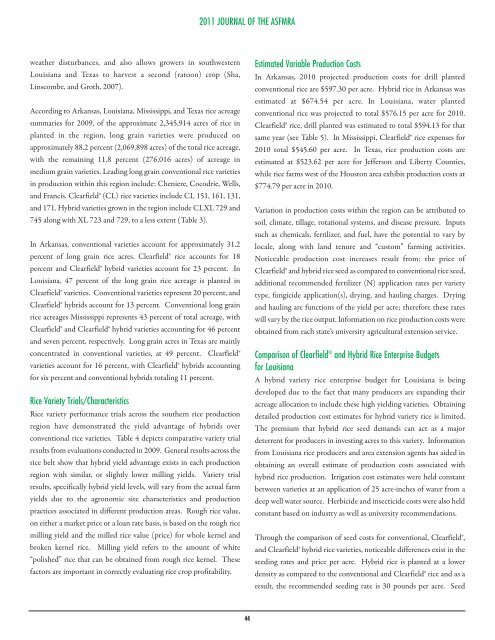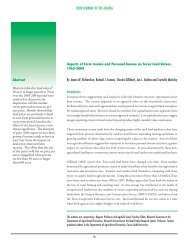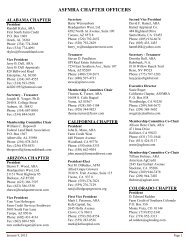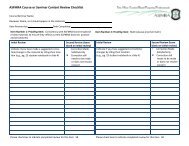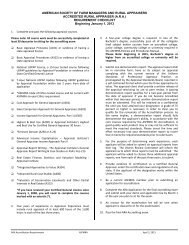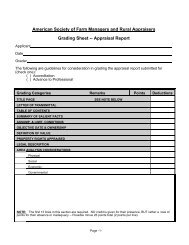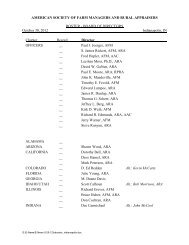Hybrid Rice Production Possibilities in the ... - AgEcon Search
Hybrid Rice Production Possibilities in the ... - AgEcon Search
Hybrid Rice Production Possibilities in the ... - AgEcon Search
Create successful ePaper yourself
Turn your PDF publications into a flip-book with our unique Google optimized e-Paper software.
2011 JOURNAL OF THE ASFMRAwea<strong>the</strong>r disturbances, and also allows growers <strong>in</strong> southwesternLouisiana and Texas to harvest a second (ratoon) crop (Sha,L<strong>in</strong>scombe, and Groth, 2007).Accord<strong>in</strong>g to Arkansas, Louisiana, Mississippi, and Texas rice acreagesummaries for 2009, of <strong>the</strong> approximate 2,345,914 acres of rice <strong>in</strong>planted <strong>in</strong> <strong>the</strong> region, long gra<strong>in</strong> varieties were produced onapproximately 88.2 percent (2,069,898 acres) of <strong>the</strong> total rice acreage,with <strong>the</strong> rema<strong>in</strong><strong>in</strong>g 11.8 percent (276,016 acres) of acreage <strong>in</strong>medium gra<strong>in</strong> varieties. Lead<strong>in</strong>g long gra<strong>in</strong> conventional rice varieties<strong>in</strong> production with<strong>in</strong> this region <strong>in</strong>clude: Cheniere, Cocodrie, Wells,and Francis. Clearfield® (CL) rice varieties <strong>in</strong>clude CL 151, 161, 131,and 171. <strong>Hybrid</strong> varieties grown <strong>in</strong> <strong>the</strong> region <strong>in</strong>clude CLXL 729 and745 along with XL 723 and 729, to a less extent (Table 3).In Arkansas, conventional varieties account for approximately 31.2percent of long gra<strong>in</strong> rice acres. Clearfield® rice accounts for 18percent and Clearfield® hybrid varieties account for 23 percent. InLouisiana, 47 percent of <strong>the</strong> long gra<strong>in</strong> rice acreage is planted <strong>in</strong>Clearfield® varieties. Conventional varieties represent 20 percent, andClearfield® hybrids account for 13 percent. Conventional long gra<strong>in</strong>rice acreages Mississippi represents 43 percent of total acreage, withClearfield® and Clearfield® hybrid varieties account<strong>in</strong>g for 46 percentand seven percent, respectively. Long gra<strong>in</strong> acres <strong>in</strong> Texas are ma<strong>in</strong>lyconcentrated <strong>in</strong> conventional varieties, at 49 percent. Clearfield®varieties account for 16 percent, with Clearfield® hybrids account<strong>in</strong>gfor six percent and conventional hybrids total<strong>in</strong>g 11 percent.<strong>Rice</strong> Variety Trials/Characteristics<strong>Rice</strong> variety performance trials across <strong>the</strong> sou<strong>the</strong>rn rice productionregion have demonstrated <strong>the</strong> yield advantage of hybrids overconventional rice varieties. Table 4 depicts comparative variety trialresults from evaluations conducted <strong>in</strong> 2009. General results across <strong>the</strong>rice belt show that hybrid yield advantage exists <strong>in</strong> each productionregion with similar, or slightly lower mill<strong>in</strong>g yields. Variety trialresults, specifically hybrid yield levels, will vary from <strong>the</strong> actual farmyields due to <strong>the</strong> agronomic site characteristics and productionpractices associated <strong>in</strong> different production areas. Rough rice value,on ei<strong>the</strong>r a market price or a loan rate basis, is based on <strong>the</strong> rough ricemill<strong>in</strong>g yield and <strong>the</strong> milled rice value (price) for whole kernel andbroken kernel rice. Mill<strong>in</strong>g yield refers to <strong>the</strong> amount of white“polished” rice that can be obta<strong>in</strong>ed from rough rice kernel. Thesefactors are important <strong>in</strong> correctly evaluat<strong>in</strong>g rice crop profitability.Estimated Variable <strong>Production</strong> CostsIn Arkansas, 2010 projected production costs for drill plantedconventional rice are $597.30 per acre. <strong>Hybrid</strong> rice <strong>in</strong> Arkansas wasestimated at $674.54 per acre. In Louisiana, water plantedconventional rice was projected to total $576.15 per acre for 2010.Clearfield® rice, drill planted was estimated to total $594.13 for thatsame year (see Table 5). In Mississippi, Clearfield® rice expenses for2010 total $545.60 per acre. In Texas, rice production costs areestimated at $523.62 per acre for Jefferson and Liberty Counties,while rice farms west of <strong>the</strong> Houston area exhibit production costs at$774.79 per acre <strong>in</strong> 2010.Variation <strong>in</strong> production costs with<strong>in</strong> <strong>the</strong> region can be attributed tosoil, climate, tillage, rotational systems, and disease pressure. Inputssuch as chemicals, fertilizer, and fuel, have <strong>the</strong> potential to vary bylocale, along with land tenure and “custom” farm<strong>in</strong>g activities.Noticeable production cost <strong>in</strong>creases result from: <strong>the</strong> price ofClearfield® and hybrid rice seed as compared to conventional rice seed,additional recommended fertilizer (N) application rates per varietytype, fungicide application(s), dry<strong>in</strong>g, and haul<strong>in</strong>g charges. Dry<strong>in</strong>gand haul<strong>in</strong>g are functions of <strong>the</strong> yield per acre; <strong>the</strong>refore <strong>the</strong>se rateswill vary by <strong>the</strong> rice output. Information on rice production costs wereobta<strong>in</strong>ed from each state’s university agricultural extension service.Comparison of Clearfield ® and <strong>Hybrid</strong> <strong>Rice</strong> Enterprise Budgetsfor LouisianaA hybrid variety rice enterprise budget for Louisiana is be<strong>in</strong>gdeveloped due to <strong>the</strong> fact that many producers are expand<strong>in</strong>g <strong>the</strong>iracreage allocation to <strong>in</strong>clude <strong>the</strong>se high yield<strong>in</strong>g varieties. Obta<strong>in</strong><strong>in</strong>gdetailed production cost estimates for hybrid variety rice is limited.The premium that hybrid rice seed demands can act as a majordeterrent for producers <strong>in</strong> <strong>in</strong>vest<strong>in</strong>g acres to this variety. Informationfrom Louisiana rice producers and area extension agents has aided <strong>in</strong>obta<strong>in</strong><strong>in</strong>g an overall estimate of production costs associated withhybrid rice production. Irrigation cost estimates were held constantbetween varieties at an application of 25 acre-<strong>in</strong>ches of water from adeep well water source. Herbicide and <strong>in</strong>secticide costs were also heldconstant based on <strong>in</strong>dustry as well as university recommendations.Through <strong>the</strong> comparison of seed costs for conventional, Clearfield®,and Clearfield® hybrid rice varieties, noticeable differences exist <strong>in</strong> <strong>the</strong>seed<strong>in</strong>g rates and price per acre. <strong>Hybrid</strong> rice is planted at a lowerdensity as compared to <strong>the</strong> conventional and Clearfield® rice and as aresult, <strong>the</strong> recommended seed<strong>in</strong>g rate is 30 pounds per acre. Seed44


